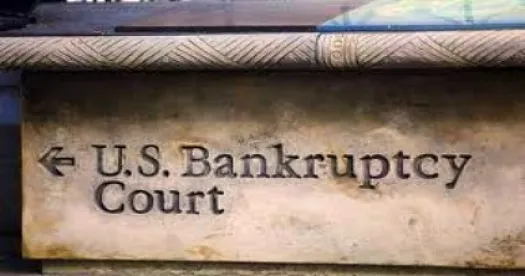On Thursday, the Supreme Court in a 5-4 decision ruled in Stern v. Marshall [1] that the congressional grant of jurisdiction to bankruptcy courts to issue final judgments on counterclaims to proofs of claim was unconstitutional. For the litigants, this decision brought an end to an expensive and drawn out litigation between the estates of former Playboy model Anna Nicole Smith and the son of her late husband, Pierce Marshall, which Justice Roberts writing for the majority analogized to the fictional litigation in Charles Dickens’ Bleak House. For bankruptcy practitioners, it is yet another chapter in an even more epic saga – that of the back-and-forth between Congress and the Supreme Court over the jurisdictional limits of the nation’s bankruptcy courts. Instead of offering finality, the decision only raises more questions about how far the Court’s reasoning will extend, and what the implications will be for practice under the Bankruptcy Code.
Background: Broad Bankruptcy Court Jurisdiction in 1978 Reform Act Ruled Unconstitutional by Supreme Court in 1982; Congress Adopts “Emergency Rule” in Response in 1984
Few who practiced then can forget the effect of the Supreme Court’s 1982 decision in Northern Pipeline [2] on the statutory regime enacted by Congress in the still-nascent Bankruptcy Code, which had gone into effect in October of 1978. The Code was a sweeping reform of the nation’s bankruptcy laws which involved elevating the previous “referees” in bankruptcy to the title of judges, and granting them the power to exercise the United States District Court’s jurisdiction over “all civil proceedings arising under title 11 [i.e., the Bankruptcy Code] or arising in or related to cases under title 11.”[3] A plurality of the Supreme Court in Northern Pipeline declared this grant of jurisdiction to bankruptcy courts under the new Bankruptcy Code unconstitutional, leaving courts and practitioners to wonder whether the Code would be thrown out the window.
The Northern Pipeline Court reasoned that granting such broad jurisdiction to bankruptcy courts was unconstitutional because bankruptcy courts were not “Article III courts” – that is, courts whose authority derives from Article III of the Constitution. Article III courts come with two principal safeguards prescribed in Article III, Section 1 of the Constitution: lifetime appointment and the inability of Congress to reduce the judges’ salaries. These safeguards are intended to ensure the courts’ independence from the other branches of government, and are thus an implementation of the separation of powers principles underlying the Constitution in general. United States District Courts are Article III courts. Bankruptcy courts, on the other hand, are Article I courts. The Northern Pipeline Court held that assigning bankruptcy courts the jurisdiction of the district courts violated Article III of the Constitution because it removed “essential attributes of the judicial power” from the Article III courts.[4]
In response, Congress enacted a new statutory scheme, embodied in 28 U.S.C. §§ 157 and 1334, which was based on the so-called “Emergency Rule” developed by the district courts after Northern Pipeline. Under this scheme, United States District Courts have original jurisdiction over matters arising under, arising in or related to cases under the Bankruptcy Code, but district courts can refer these matters to the bankruptcy courts (a referral that is now automatic in all districts). Bankruptcy courts are given the power to issue final judgments in all “core proceedings” arising under the Bankruptcy Code, or arising in a case under the Bankruptcy Code. As to other, “non-core” matters related to a case under the Bankruptcy Code, bankruptcy courts can only issue proposed findings of fact and conclusions of law for de novo review by the district court, unless the parties otherwise consent. This statutory scheme went into effect in 1984.
History of Stern v. Marshall
Stern v. Marshall presented the Supreme Court with the opportunity to review the statutory scheme adopted by Congress in 1984. The model and actress Anna Nicole Smith had filed for bankruptcy in Los Angeles after the death of her billionaire husband, J. Howard Marshall, in 1995. Bitter litigation that had begun even before her husband’s death continued in the bankruptcy court between Smith and her late husband’s son, Pierce Marshall, over their competing claims to the Marshall estate.
In Smith’s bankruptcy case, Pierce filed both a proof of claim for defamation and an adversary complaint seeking a determination that his defamation claim was nondischargeable. Smith filed a compulsory counterclaim for tortious interference by Pierce with the gift she expected from her late husband. The bankruptcy court held a trial and granted judgment to Smith in the amount of $447 million.
Appeals and parallel litigation ensued, all of which cannot be described here, or in a manuscript of less than ten volumes. In short, after the entry of the bankruptcy court's extraordinary judgment Pierce prevailed in a separate trial on the merits in Texas state court. Thereafter, Smith prevailed in a de novo review of the bankruptcy court’s judgment in federal district court in Los Angeles, though her $447 million judgment was reduced to $44 million. In this second round before the Supreme Court, the issue was very simple - did the bankruptcy court have jurisdiction to enter a final judgment on Pierce's counterclaim? If so, that judgment would be the first final judgment in the matter and would thereby have a preclusive effect under principles of res judicata on the later Texas judgment in Pierce's favor. If not, the Texas judgment would be the first final judgment and preclude the later district court judgment in Smith's favor. In an earlier appeal, the Supreme Court had determined that the probate exception to federal jurisdiction did not apply in the case to render void the bankruptcy court judgment, sending the matter back to the Ninth Circuit to determine whether the bankruptcy court judgment had a preclusive effect on the Texas court contrary judgment based on other principles.
Supreme Court’s Holding
The Supreme Court held that while Smith’s compulsory counterclaim to Pierce's proof of claim was clearly a “core proceeding” under the language of 28 U.S.C. § 157(b)(2)(C), the statute itself was unconstitutional. The Court held that Congress cannot grant to the bankruptcy courts (as Article I courts) the power to issue final judgments on common law causes of action like Smith’s counterclaim that are not resolved in the process of ruling on the proof of claim. The Court reasoned that any suit that is “the stuff of the traditional actions at common law tried by the courts at Westminster in 1789, and is brought within the bounds of federal jurisdiction,” is within the exclusive jurisdiction of Article III courts. Permitting Congress to take such actions out of Article III courts’ jurisdiction would frustrate the separation of powers principles of Article III and render that Article ineffective.[5]
The Court rejected the argument put forward by Smith that the so-called “public rights” exception applied and permitted Congress to grant bankruptcy courts the authority to issue final decisions on counterclaims like Smith’s. The Court found that Smith’s counterclaim did not fall under any of the formulations of the public rights exception for several reasons, including: (i) Smith’s counterclaim did not flow from a federal statutory scheme, (ii) Smith’s counterclaim was not completely dependent upon adjudication of a claim created by federal law, (iii) Pierce did not truly consent to bankruptcy court jurisdiction, since he had nowhere else to go but bankruptcy court if he wished to recover from Smith’s bankruptcy estate; and (iv) the case did not involve a situation where a specialized subset of matters was assigned to a special administrative agency, but rather a situation where a common law action was sought to be determined by a court with broad substantive jurisdiction.[6]
Potential Implications of Stern v. Marshall
The Supreme Court’s holding was limited to one subsection of 28 U.S.C. § 157(b) – in particular subsection (b)(2)(C) which provides that counterclaims to proofs of claim are core proceedings. Indeed, the Court asserted that its holding does not “meaningfully change[] the division of labor in the current statute,”[7] though in the same breath it also stated that a statute’s efficiency or convenience will not save it if it is contrary to the Constitution.[8]
However, the Court’s reasoning is broad, and can potentially be applied to other subsections, such as section 157(b)(2)(H) pertaining to fraudulent conveyance actions, which the Supreme Court has previously held to be “quintessentially suits at common law,”[9] and/or section 157(b)(2)(K), pertaining to determinations of the validity, extent and priority of liens, which are generally determined by state law.
Also, even if limited to section 157(b)(2)(C), counterclaims by the estate are a common occurrence in bankruptcy. As the dissent noted, the Court’s ruling may lead to gamesmanship between creditors and debtors in litigation over proofs of claim, with the proof of claim being decided in the bankruptcy court and a parallel proceeding occurring in the district court. All of this would lead to increased costs and delay – neither of which a typical debtor or creditor can afford. Writing for the dissent, Justice Breyer referred to this as “a constitutionally required game of jurisdictional ping-pong” which will lead to “inefficiency, increased cost, delay and needless additional suffering among those faced with bankruptcy.”[10]
A Potential Fix: Bankruptcy Courts as Article III Courts
Historically, Congress has rewritten or substantially revised the nation’s bankruptcy laws approximately once every 40 years – witness the Bankruptcy Act of 1898, followed by the Bankruptcy Act of 1938, followed yet again by the Bankruptcy Reform Act of 1978. The Bankruptcy Code itself has been amended in significant respects on multiple occasions, including in 1984, 1994 and 2005. The potentially inefficient jurisdictional system following the Supreme Court’s ruling in Stern v. Marshall may be cause to take up the drafting pen yet again. This time, Congress may consider taking a step it deliberately refrained from taking in 1978 and 1984 – that is, providing for bankruptcy courts to be Article III courts by making bankruptcy judges appointed for life and immune to salary reductions by Congress. This would avoid the core/non-core mire altogether in favor of a system of clarity and efficiency that should benefit most debtors and creditors, and well as the bankruptcy courts and district courts.
[1] See, Stern v. Marshall, __ U.S. __, No. 10-179 (June 23, 2011).
[2] See, Northern Pipeline Construction Co. v. Marathon PipeLine Co., 458 U.S. 50 (1982).
[3] See, 11 U.S.C. § 1471(c), repealed by Pub. L. No. 98-353 § 122 (1984).
[4] Northern Pipeline, 458 U.S. at 81. TEXT
[5] Stern v. Marshall, supra, slip op. at 18.
[6] Id., slip op. at 22-29.
[7] Id., slip op. at 37.
[8] Id., slip op. at 36.
[9] See, Granfinanciera, S.A. v. Nordberg, 492 U.S. 33, 56 (1989).
[10] Stern v. Marshall, slip op. at 17 (Breyer, J., dissenting)



 />i
/>i

